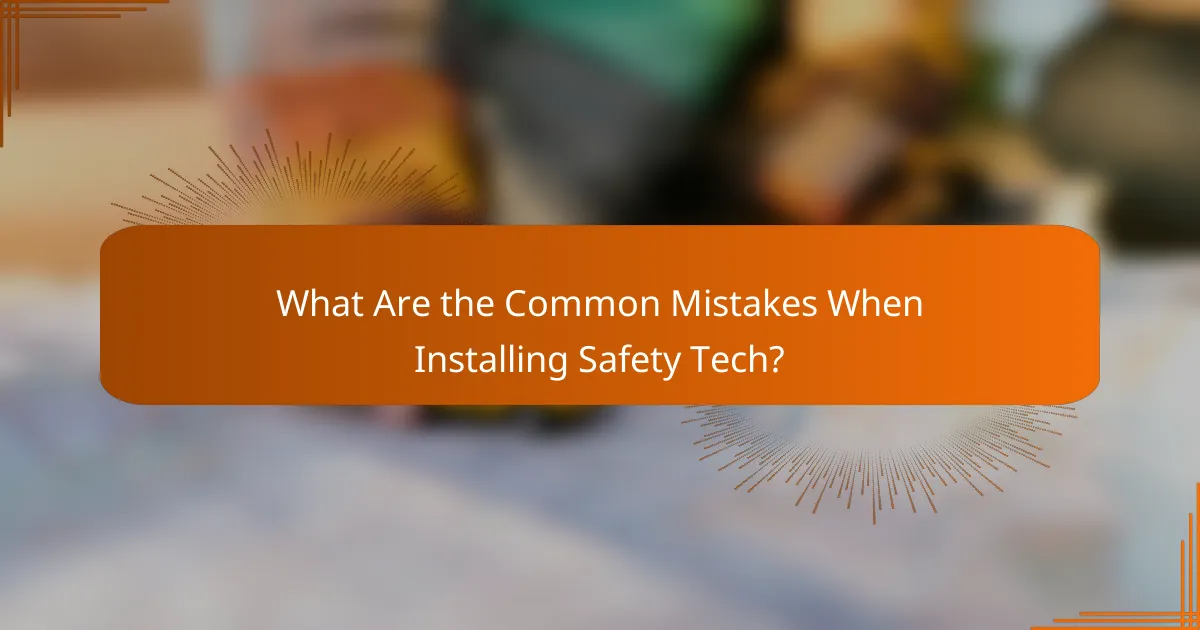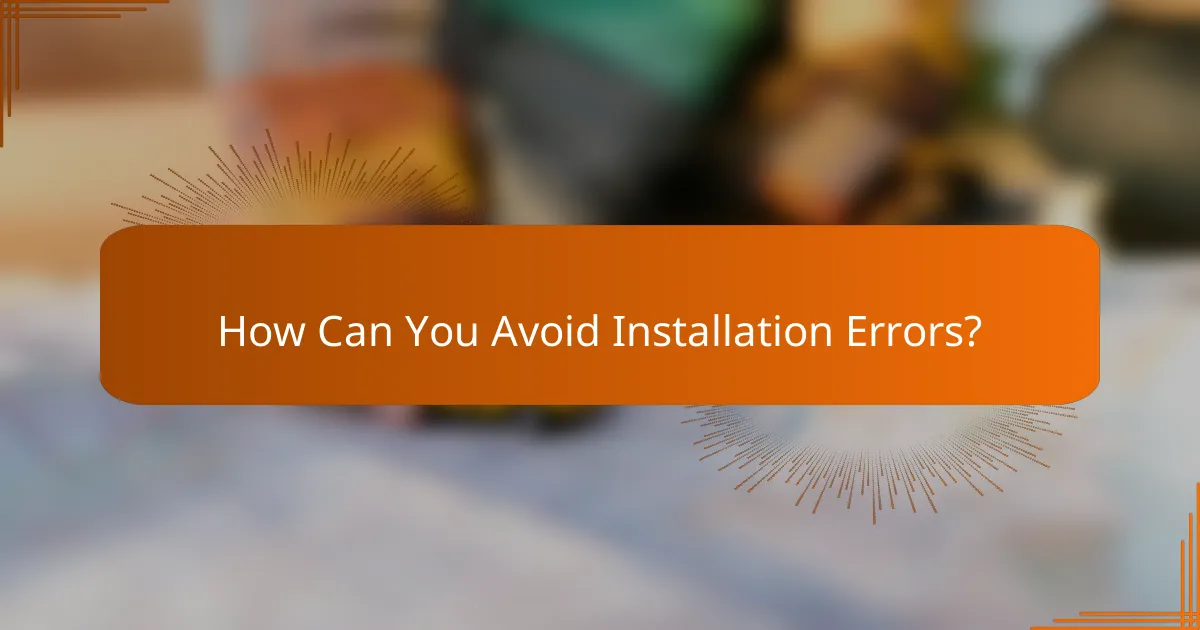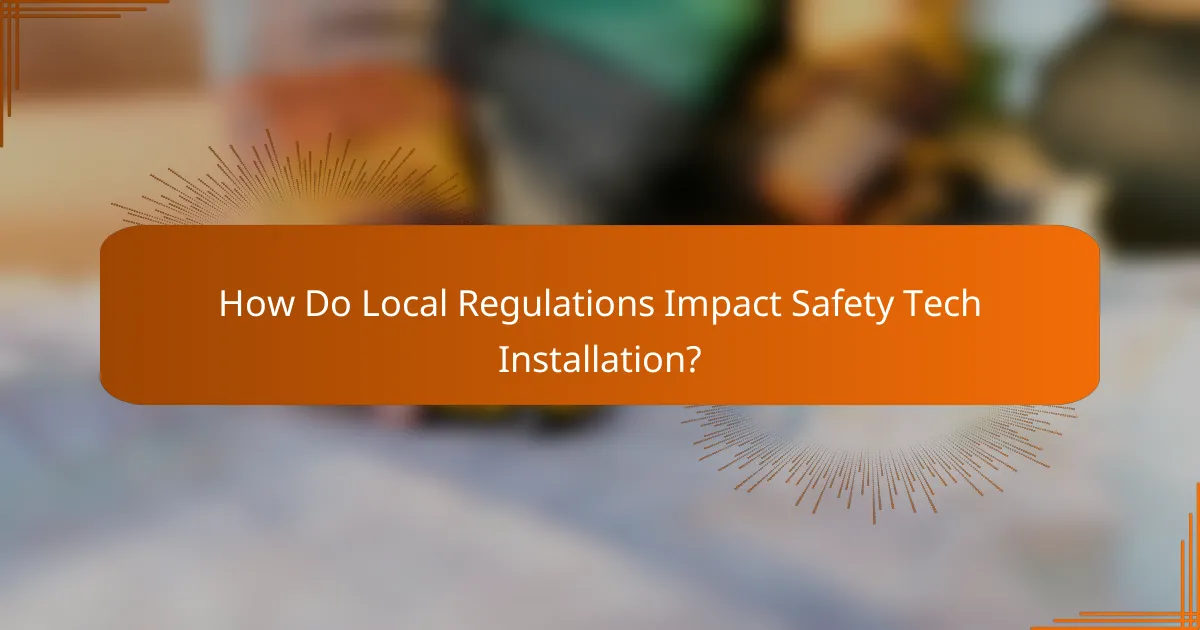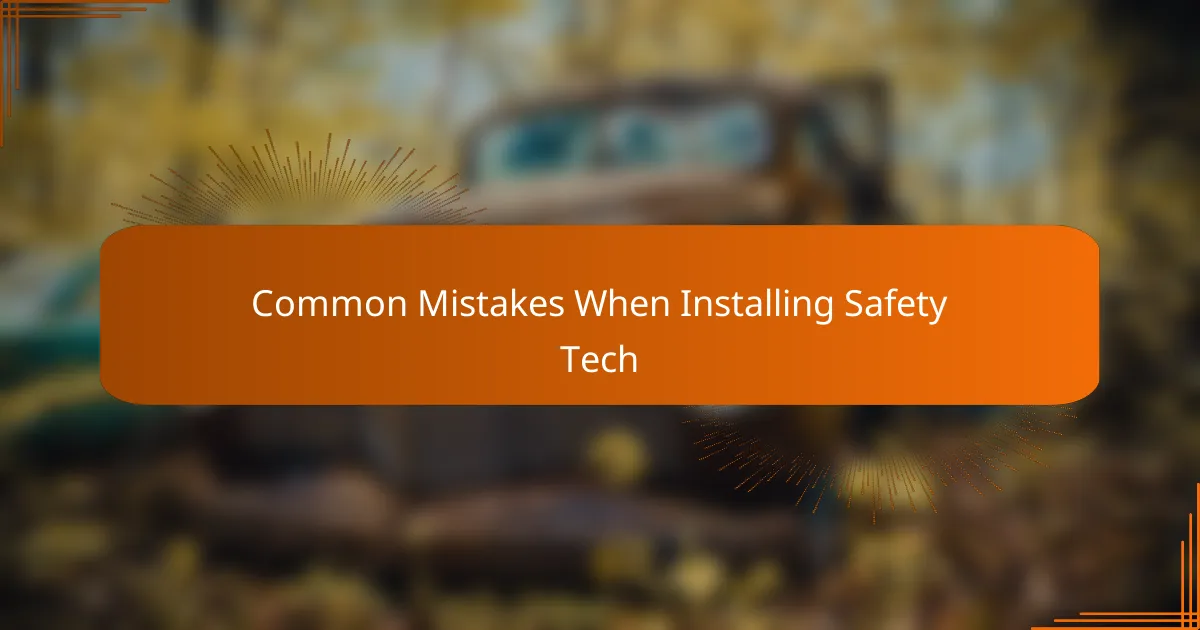Installing safety technology is crucial for ensuring security, but common mistakes can significantly undermine its effectiveness. By recognizing these pitfalls and following a structured approach, including utilizing checklists and consulting experts, you can enhance the installation process and ensure optimal performance of your safety systems.

What Are the Common Mistakes When Installing Safety Tech?
Common mistakes during the installation of safety technology can compromise its effectiveness and reliability. Understanding these pitfalls can help ensure a successful setup and optimal performance of safety systems.
Improper placement of devices
Improper placement of safety devices can lead to reduced effectiveness and coverage gaps. For instance, security cameras should be positioned to avoid obstructions and provide a clear view of entry points.
Consider the field of view and the height at which devices are installed. A common guideline is to mount cameras at least 2.5 to 3 meters above ground level for optimal visibility.
Neglecting compatibility with existing systems
Failing to check compatibility with existing safety systems can result in integration issues. Before installation, verify that new devices can communicate with current systems, such as alarms or monitoring software.
Using devices from the same manufacturer can often simplify compatibility. Always consult product specifications and user reviews to ensure seamless integration.
Ignoring user manuals
Ignoring user manuals is a frequent mistake that can lead to improper installation and functionality issues. Manuals provide essential information on setup procedures, configuration settings, and troubleshooting tips.
Take the time to read through the manual thoroughly before starting the installation. Highlight key steps and refer back to the manual during the process to avoid errors.
Overlooking power supply requirements
Overlooking power supply requirements can cause devices to malfunction or fail to operate. Ensure that all safety tech devices are compatible with the available power sources and that they meet voltage and current specifications.
For wired devices, check that the installation site has proper electrical outlets and consider using surge protectors to safeguard against power spikes.
Failing to test functionality
Failing to test the functionality of safety tech after installation can leave vulnerabilities unaddressed. Conduct thorough tests to confirm that all devices operate as intended and that alerts are functioning correctly.
Set aside time for a comprehensive testing phase, ideally within a few days of installation. Regular maintenance checks should also be scheduled to ensure ongoing reliability.

How Can You Avoid Installation Errors?
To avoid installation errors when setting up safety technology, follow a structured approach that includes using checklists, consulting experts, and leveraging manufacturer resources. These steps ensure a smoother installation process and enhance the effectiveness of the safety systems.
Follow a detailed installation checklist
A detailed installation checklist helps you systematically verify each step of the process, reducing the likelihood of mistakes. Start by outlining all necessary components, tools, and procedures specific to your safety technology system.
Checklists can include steps such as verifying equipment compatibility, ensuring proper power supply, and confirming network connectivity. Regularly reviewing your checklist during installation can help catch errors before they become significant issues.
Consult professional installers
Hiring professional installers can significantly reduce the risk of installation errors. Experienced technicians understand the nuances of safety technology and can navigate complex setups more effectively than a DIY approach.
Consider seeking out certified installers who are familiar with local regulations and standards. This ensures compliance and enhances the overall safety and functionality of the system.
Use manufacturer support resources
Manufacturer support resources, such as installation manuals, online tutorials, and customer service, are invaluable for avoiding installation errors. These resources often provide detailed guidance tailored to specific products.
Take advantage of online forums and FAQs offered by manufacturers, as they can provide insights from other users’ experiences. If you encounter challenges, don’t hesitate to reach out to customer support for clarification or assistance.

What Tools Are Essential for Safety Tech Installation?
Essential tools for safety tech installation include drills, screwdrivers, wire strippers, connectors, and multimeters. These tools ensure that installations are secure, efficient, and compliant with safety standards.
Drills and screwdrivers
Drills and screwdrivers are fundamental for securely mounting safety devices. A power drill can quickly create holes for anchors, while a set of screwdrivers allows for precise tightening of screws. Consider using a cordless drill for flexibility and ease of use.
When selecting screwdrivers, ensure you have both flathead and Phillips options in various sizes to accommodate different screws. Using the correct screwdriver type prevents stripping screws and damaging materials.
Wire strippers and connectors
Wire strippers and connectors are crucial for safely handling electrical wiring during installation. Wire strippers allow you to remove insulation from wires without damaging the conductor, ensuring a proper connection. Always choose strippers that match the wire gauge you are working with.
Connectors, such as terminal blocks or crimp connectors, facilitate secure and reliable electrical connections. Make sure to select connectors that are rated for the voltage and current of your safety tech devices to avoid overheating or failures.
Multimeters for testing
Multimeters are essential for testing electrical circuits and ensuring that installations are functioning correctly. They can measure voltage, current, and resistance, helping to diagnose issues before they become serious problems. A digital multimeter is recommended for its ease of reading and accuracy.
When using a multimeter, familiarize yourself with its settings and functions. Regular testing can prevent safety hazards and ensure compliance with electrical standards. Always follow safety protocols when working with live circuits to avoid accidents.

What Are the Best Practices for Safety Tech Setup?
Best practices for safety tech setup involve thorough planning and execution to ensure effective and reliable operation. Key steps include conducting site surveys, configuring networks properly, and maintaining updated software and firmware.
Conduct a site survey before installation
Performing a site survey is essential to identify the optimal locations for safety tech devices. This process involves assessing the physical environment, understanding potential obstacles, and determining the best coverage areas for cameras, sensors, or alarms.
During the survey, consider factors such as lighting conditions, potential interference from structures, and accessibility for maintenance. Documenting these findings will help in creating a comprehensive installation plan that maximizes effectiveness.
Ensure proper network configuration
Proper network configuration is crucial for the seamless operation of safety tech systems. Ensure that your network can handle the data load from devices, which may include video feeds and alerts, without lag or interruptions.
Utilize a dedicated network for safety tech if possible, and implement security measures such as firewalls and encryption to protect sensitive data. Regularly test the network for speed and reliability to prevent issues that could compromise safety.
Regularly update software and firmware
Regular updates to software and firmware are vital for maintaining the security and functionality of safety tech systems. These updates often include patches for vulnerabilities, new features, and improvements in performance.
Establish a routine schedule for checking and applying updates, and consider enabling automatic updates where feasible. This proactive approach helps prevent security breaches and ensures that your safety tech remains effective against evolving threats.

How Do Local Regulations Impact Safety Tech Installation?
Local regulations significantly influence safety tech installation by establishing minimum standards for equipment and procedures. Compliance with these regulations ensures that installations are safe, effective, and legally sound.
Understanding building codes
Building codes dictate the structural and safety requirements for construction and renovation projects, including the installation of safety technology. These codes vary by location and can include specifications for materials, installation methods, and maintenance practices.
Before beginning an installation, check your local building codes to ensure compliance. For example, some areas may require specific types of smoke detectors or alarm systems that meet certain performance criteria.
Compliance with fire safety standards
Fire safety standards are critical for ensuring that safety tech functions effectively during emergencies. These standards often include guidelines for the installation of fire alarms, sprinkler systems, and emergency lighting.
To comply with fire safety standards, verify that all equipment is certified by recognized organizations, such as Underwriters Laboratories (UL) or the National Fire Protection Association (NFPA). Regular inspections and maintenance are also essential to ensure ongoing compliance and functionality.
